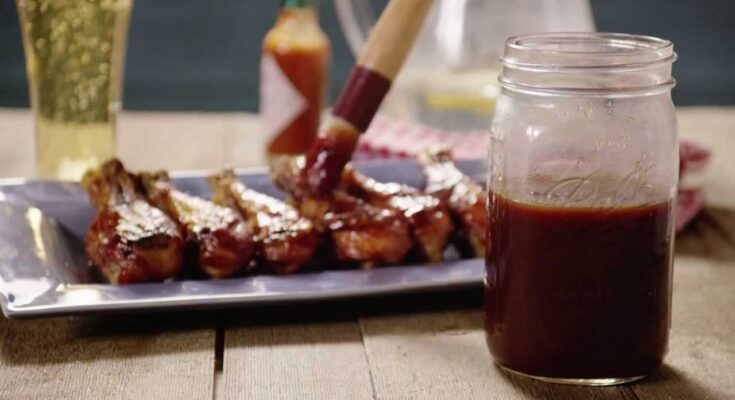Barbecue Sauce Recipe: Barbecue sauce is a flavorful condiment widely used for grilling, marinating, and dipping. It typically combines sweet, tangy, and smoky elements, making it a favorite for enhancing the taste of meats like ribs, chicken, and pork. Its versatility also extends to sandwiches, burgers, and even roasted vegetables.
Barbecue sauce dates back to early American cooking traditions, blending influences from Native American, African, and European cuisines. Today, it comes in numerous styles, including Kansas City, Memphis, and Carolina variations, each with distinct flavors and textures.
Why Make Homemade Barbecue Sauce?
Store-bought barbecue sauces are convenient, but making your own allows you to customize the flavor, control the ingredients, and avoid preservatives. Homemade barbecue sauce also offers better quality and freshness, making it a healthier and tastier alternative.
By making it yourself, you can create spicy, tangy, smoky, or sweet versions tailored to your preference. Plus, it’s an easy and rewarding cooking process that requires minimal effort and delivers maximum flavor.
Ingredients for Barbecue Sauce
Essential Ingredients for Classic Barbecue Sauce
To make a traditional barbecue sauce, you’ll need the following key ingredients:
- Tomato Base: Tomato paste, ketchup, or canned tomatoes provide the primary base.
- Sweetener: Brown sugar, honey, or molasses adds sweetness and richness.
- Acidic Component: Vinegar or lemon juice balances the sweetness with tanginess.
- Flavor Enhancers: Mustard, Worcestershire sauce, and soy sauce deepen the flavor.
- Spices and Seasonings: Garlic powder, onion powder, paprika, and chili powder create a complex flavor profile.
- Liquid Smoke: For a smoky flavor, this optional ingredient is a game-changer.
Optional Ingredients for Custom Flavor Profiles
- Heat: Add cayenne pepper, hot sauce, or red pepper flakes for a spicier version.
- Fruity Twists: Pineapple juice, apple cider, or mango puree for a fruity touch.
- Alcohol Additions: Bourbon or whiskey can add depth and richness.
- Herbs: Fresh cilantro or parsley for herbal notes.
- Creamy Additions: Mustard or mayonnaise for a smoother texture.
Step-by-Step Guide to Making Barbecue Sauce
Step 1: Gathering Ingredients and Tools
Before you start, ensure you have:
- Measuring cups and spoons
- A medium-sized saucepan
- A whisk or spoon for stirring
- A blender (optional, for smoother texture)
- Jars or bottles for storage
Gather all ingredients in advance to streamline the cooking process.
Step 2: Mixing the Base Ingredients
- Begin with the tomato base—add 1 cup of ketchup or tomato paste into the saucepan.
- Pour in ½ cup of apple cider vinegar for tanginess.
- Add ⅓ cup of brown sugar or honey for sweetness.
- Stir in 1 tablespoon of Worcestershire sauce and 1 teaspoon of mustard for umami depth.
- Sprinkle in garlic powder, onion powder, paprika, and chili powder (about 1 teaspoon each).
Mix thoroughly to ensure all ingredients blend evenly.
Step 3: Simmering for Flavor Enhancement
- Place the saucepan over medium heat.
- Stir continuously until the mixture begins to bubble gently.
- Reduce the heat to low and let it simmer for 15–20 minutes, stirring occasionally.
- Allow the flavors to meld as the sauce thickens.
Simmering enhances the flavor and texture, making the sauce richer and more aromatic.
Step 4: Tasting and Adjusting Seasoning
Taste the sauce as it cooks and make adjustments:
- Too tangy? Add more sugar or honey.
- Too sweet? Increase vinegar or add lemon juice.
- Need more heat? Sprinkle additional chili flakes or hot sauce.
Customizing the flavor ensures the sauce meets your personal preference.
Step 5: Cooling and Storing the Sauce
- Once the sauce has thickened and the flavor is balanced, remove it from heat.
- Let it cool completely before transferring it to a clean, airtight jar or bottle.
- Store in the refrigerator for up to 2 weeks.
For longer storage, freeze portions in small containers.
Tips for Perfect Barbecue Sauce
How to Balance Sweetness, Tanginess, and Spice
Creating the perfect barbecue sauce is all about balance. The ideal sauce should have a harmonious mix of sweetness, tanginess, and spice. Here’s how you can achieve that balance:
- Sweetness: Use brown sugar, honey, molasses, or maple syrup for depth. Add gradually and taste as you go.
- Tanginess: Apple cider vinegar, lemon juice, or mustard provides acidity to cut through sweetness. Adjust in small increments to avoid overpowering the flavor.
- Spice: Cayenne pepper, chili powder, or hot sauce adds heat. Start with a small amount and add more based on your spice tolerance.
- Umami Flavor: Worcestershire sauce, soy sauce, and garlic enhance richness.
Pro Tip: Add ingredients in layers and let the sauce simmer between adjustments to allow flavors to meld properly.
Common Mistakes to Avoid When Making Barbecue Sauce
- Overcooking the Sauce: Simmering too long can lead to burnt flavors. Always stir occasionally and keep the heat low.
- Too Much Sugar: While sweetness is key, adding too much sugar can make the sauce sticky and prone to burning when grilled. Balance sweetness with acidity.
- Skipping Simmering Time: Allow the sauce to simmer for at least 15–20 minutes to bring out the flavors. Skipping this step may result in a flat-tasting sauce.
- Not Tasting Frequently: Tasting throughout the process ensures you can make adjustments before the sauce is finalized.
- Ignoring Consistency: If the sauce is too thin, simmer longer to thicken it. Alternatively, use a cornstarch slurry to speed up the process.
Barbecue Sauce Variations
Smoky Barbecue Sauce
For a deep, smoky flavor:
- Add 1–2 teaspoons of liquid smoke.
- Use smoked paprika instead of regular paprika.
- Incorporate a splash of bourbon for added richness.
Spicy Barbecue Sauce
For those who like it hot:
- Add hot sauce or Sriracha (1–2 tablespoons).
- Increase cayenne pepper or add red pepper flakes.
- Balance the heat with a touch of honey or maple syrup.
Honey Mustard Barbecue Sauce
For a tangy twist:
- Add ¼ cup of yellow mustard.
- Stir in 2 tablespoons of honey for sweetness.
- Enhance with a dash of cider vinegar for a sharp flavor.
Vinegar-Based Barbecue Sauce
Popular in Carolina-style barbecue:
- Use apple cider vinegar as the primary base instead of ketchup.
- Add crushed red pepper flakes and a touch of brown sugar for flavor balance.
- This thinner sauce is great for pulled pork and marinades.
Serving Suggestions
Best Foods to Pair with Barbecue Sauce
Barbecue sauce pairs well with a wide range of foods:
- Grilled Meats: Ribs, chicken wings, pork chops, and brisket.
- Sandwiches: Pulled pork sliders and barbecue chicken sandwiches.
- Burgers: Use as a topping for beef or turkey burgers.
- Vegetables: Brush on grilled corn, zucchini, or eggplant.
- Seafood: Glaze shrimp, salmon, or scallops for a smoky flavor.
Creative Uses for Barbecue Sauce Beyond Grilling
- Dipping Sauce: Perfect for fries, onion rings, and nuggets.
- Pizza Sauce Substitute: Spread over pizza dough for a BBQ chicken pizza.
- Stir-Fry Base: Toss vegetables and chicken in barbecue sauce for a unique stir-fry.
- Glaze for Roasted Vegetables: Carrots, Brussels sprouts, and sweet potatoes taste amazing with a barbecue glaze.
- Marinade for Proteins: Use as a marinade for tofu, tempeh, or meats before grilling.
FAQs about Barbecue Sauce Recipe
1. What are the basic ingredients in a barbecue sauce recipe?
A typical barbecue sauce recipe includes ingredients such as ketchup or tomato sauce, vinegar, sugar (often brown sugar), Worcestershire sauce, and various spices like garlic powder, onion powder, and mustard powder. Some recipes might also include liquid smoke for a deeper flavor.
2. Can I make barbecue sauce without sugar?
Yes, you can make barbecue sauce without sugar by substituting it with natural sweeteners like honey, maple syrup, or molasses. These alternatives provide a rich flavor while reducing processed sugar content.
3. How long does homemade barbecue sauce last?
Homemade barbecue sauce can last up to a week when stored in the refrigerator in an airtight container. For longer storage, you can freeze it for up to three months.
4. Is it possible to make a spicy barbecue sauce?
Absolutely! To add heat to your barbecue sauce, incorporate ingredients like cayenne pepper, hot sauce, or diced jalapeños. Adjust the amount based on your preferred spice level.
5. What are some creative uses for barbecue sauce beyond grilling?
Barbecue sauce is versatile and can be used in various dishes. Use it as a marinade for meats, a flavorful addition to baked beans, a dipping sauce for appetizers, or a zesty spread on burgers and sandwiches.
6. Can I make barbecue sauce suitable for vegans?
Yes, to make vegan barbecue sauce, ensure that all ingredients, particularly Worcestershire sauce, are vegan. Many brands offer a vegan version of Worcestershire sauce that doesn’t contain anchovies.
Conclusion
Making your own barbecue sauce at home is a fun and rewarding process. It allows you to experiment with flavors, avoid preservatives, and create a healthier option that suits your taste. Whether you prefer smoky, sweet, or spicy varieties, this guide gives you the foundation to create the perfect sauce for any occasion.
Homemade barbecue sauce can elevate simple dishes, turning them into gourmet meals. So, gather your ingredients, fire up the stove, and start creating your signature barbecue sauce today.



